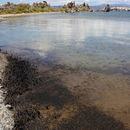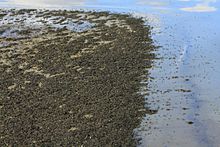en
names in breadcrumbs


The Kuzedika Paiute Indians native to the Mono Lake area traditionally seined inshore waters in August, harvesting bushels of larvae and pupae they called “koo-tsabe,” as an important component of their diet.The larvae and pupae were dried and the shell (laboriously) removed so that the oily kernel-like inside could be eaten (sometimes ground as flour).Other native people, historically as far south as Lake Texcoco near Mexico City are also cited as harvesting E. hians in large quantity, following the customs of ancient Aztecs (Williston 1883; Aldrich 1912).
The dipteran Alkali Fly, Ephydra hians, (a species in the large family Ephydradae) also called the Mono Lake Alkali Fly, is as its name suggests, well-known from the shores of Mono Lake in California.It is found around multiple other high salinity alkali lakes in the western United States, notably Owen’s Lake and Great Salt Lake, and occurs east as far as Minnesota and south to Mexico. At certain times in summer this small (4.2-6.3mm in length) fly occurs in windrows of remarkable number, darkening the lake's shore with their black bodies and alighting on any surface or perch they can find (Jones and Stokes Associates, 1993; Harris and Wilhelm 2011; Schusteff 2014).
The combination of high salinity and alkalinity of the lakes E. hians inhabits makes other aquatic denizens very rare -- Herbst (1988) recorded just six other insect species from Mono Lake -- but the aquatic larva of the alkali fly has adapted to living in a highly alkaline environment by expansion of the physiology of its lime gland, used by other insects for removing nitrogenous waste, to also process excess carbonate and bicarbonate ions.The gland concentrates carbonates from the blood and precipitates it with calcium to store as limestone (calcium carbonate), which is released when the larva pupates (Jones and Stokes Associates, 1993; Herbst 1988; Harris and Wilhelm 2011).
Adult flies represent the terrestrial portion of this species’ lifecycle, but like the larvae they eat benthic algae such as diatoms, filamentous green algae, blue green algae (and probably also bacteria and protozoa) and as adults they regularly submerge to feed on high quality food.Claw-like prolegs and a covering of setae help them cling to underwater surfaces, and the setae creates an air bubble around them, allowing them to remain underwater for a long time (Jones and Stokes Associates, 1993; Herbst 1988; Harris and Wilhelm 2011).Adults and hatching pupae have been recorded at depths of up to 8 meters, and 1 km from shore although presumably more nutritious food and better ovipositing spots are found in shallower water (Foley and White 1989). Mark Twain wrote of alkali flies:
“You can hold them under water as long as you please–they do not mind it—they are only proud of it. When you let them go, they pop up to the surface as dry as a patent office report, and walk off as unconcernedly as if they had been educated especially with a view to affording instructive entertainment to man in that particular way. – Roughing It (1872)”
Adult flies swim or pull themselves along submerged objects to reach the lake bottom, where they prefer to lay their eggs in crannies of hard substrates (especially tufa towers and boulders in Mono Lake), sometimes underneath algal mats and debris. Larvae hatch in just 1-3 days and develop through three larval instars over 1-5 months, depending on temperature and food availability. When ready, the third instar larva attaches to an underwater rock to pupate and emerges as an adult 1-3 weeks later.At Mono Lake, 1-3 generations may occur in a season; the species usually overwinters as larvae (Jones and Stokes Associates, 1993; Herbst 1988; Harris and Wilhelm 2011).
Because of the alkalinity of the Mono Lake environment, competition with and predation on E. hians by other insects is negligible.However, at lakes with lower salinity levels (e.g. Lake Abert, in Oregon) a range of terrestrial insects prey on the flies. Parasitic wasps as well as beetles, and larval damselflies, doliochipodids, and tabanids can greatly reduce larval numbers (Herbst 1988; Jones and Stokes Associates 1993). In summer months upturn from winds and waves cause a consistent drift of larvae and pupae (estimated from surveys of Mono Lake to make up about a metric ton of biomass; Herbst 1990), which along with the enormous windrow of adult flies on shore, attract bird predators in large numbers no matter the salinity of the environment (Herbst 1988, 1990; Harris and WIlhelm 2011; Jones and Stokes Associates 1993).
Ephydra hians, commonly known as the alkali fly, is a species of fly in the family Ephydridae, the brine flies.[2]
The body of the adult is dark brown, and roughly 4–7 millimeters (0.16–0.28 in) in length. The thorax reflects a metallic greenish or bluish color, and the wings are smokey brown.[3]
The larva contains a membranous cephalic area, and the rest of the body is divided into 3 thoracic segments and 8 abdominal segments.[3]

This species is found mostly in the northwestern United States, as well as in Canada and Mexico. The preferred habitat is in the benthic-littoral zone, in habitats containing large amounts of tufa (a porous limestone deposit). Mono Lake in California has a large population of this species.[4]
Throughout the summertime, the flies, which live for 3 to 5 days, feed and lay eggs under the surface of the water. Upon hatching, the larvae roam underwater, feeding on algae and bacteria. They remain under the water until they develop into adults, acquiring oxygen supplied by photosynthesis of the algae.
Once in the adult stage, the flies are able to walk upon and beneath the water, feeding on algae. They are able to submerge themselves to depths of up to 24 feet (7.3 m) thanks to short, waxy hairs on their body, which trap a bubble of air around their bodies. This bubble is not consumed by the fly as it clambers down submerged rocks, rather its surface area is used to transpire gasses with the lakewater. In this way, the diving flies can remain submerged for up to 15 minutes in their search for algae or secluded areas for egg-laying.[5] The hypersaline water of their habitat is especially wet, requiring the fly to have extra hair and special waxes to maintain this air bubble. When diving, a force equivalent to roughly 18 times the body weight of the fly is required to break through the surface tension of the water.[6]
Ephydra hians are susceptible to changes in temperature. When the temperature gets colder, their life span prolongs and the individual stages of development take longer. Adult flies do not lay eggs in the winter months due to the inability to undergo adequate development, thus creating a pause in reproduction. These flies also don't surpass a depth of roughly 15 meters due to the frigid temperatures. The favorable temperatures in spring and autumn are most suitable for growth.[4]
You can hold them under water as long as you please--they do not mind it--they are only proud of it. When you let them go, they pop up to the surface as dry as a patent office report, and walk off as unconcernedly as if they had been educated especially with a view to affording instructive entertainment to man in that particular way.
The Kucadikadi, a band of Northern Paiute people, historically used the pupae of this fly as a source of protein and fat. The name "Kucadikadi" means "eaters of the brine fly pupae". Year-round, but particularly in the summer, approximately 200 Kucadikadi harvested the pupae at Mono Lake. The pupae can be used to make stew after being dried. Considered a delicacy, the Kucadikadi also traded the pupae with others in the region.[2][8][9]
Ephydra hians, commonly known as the alkali fly, is a species of fly in the family Ephydridae, the brine flies.